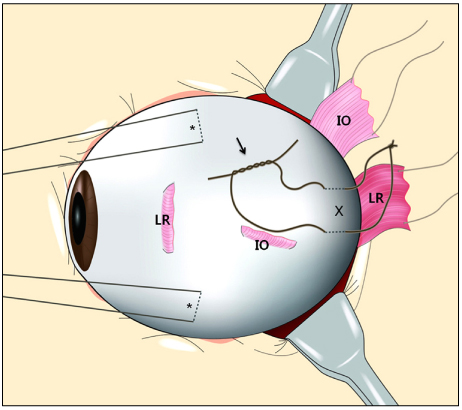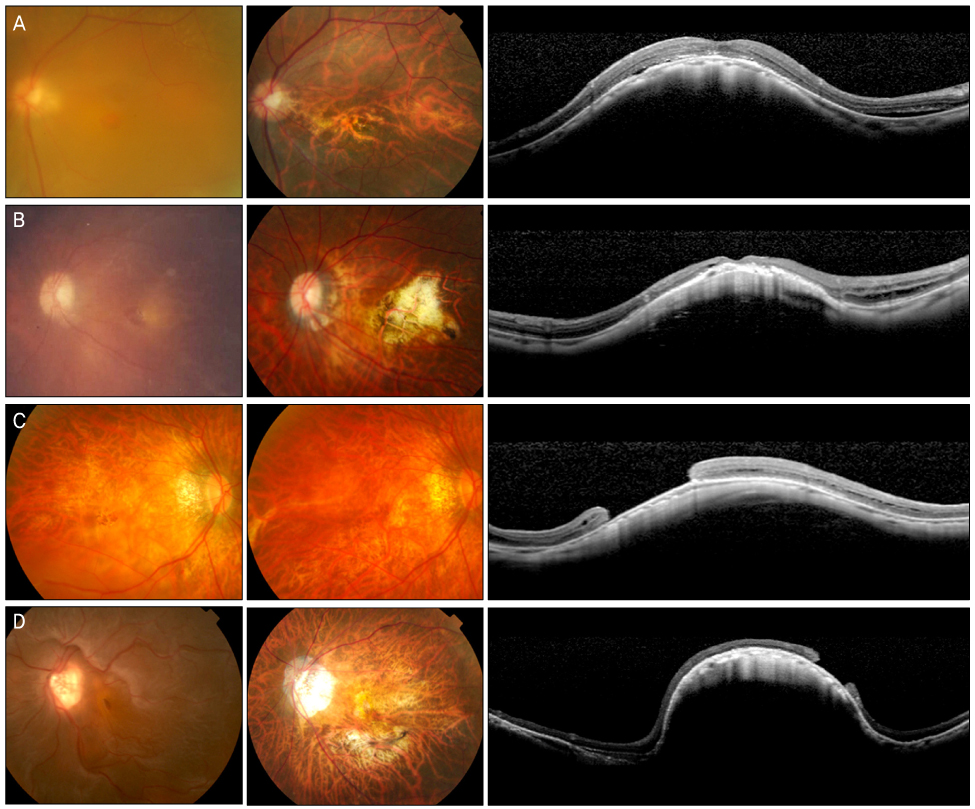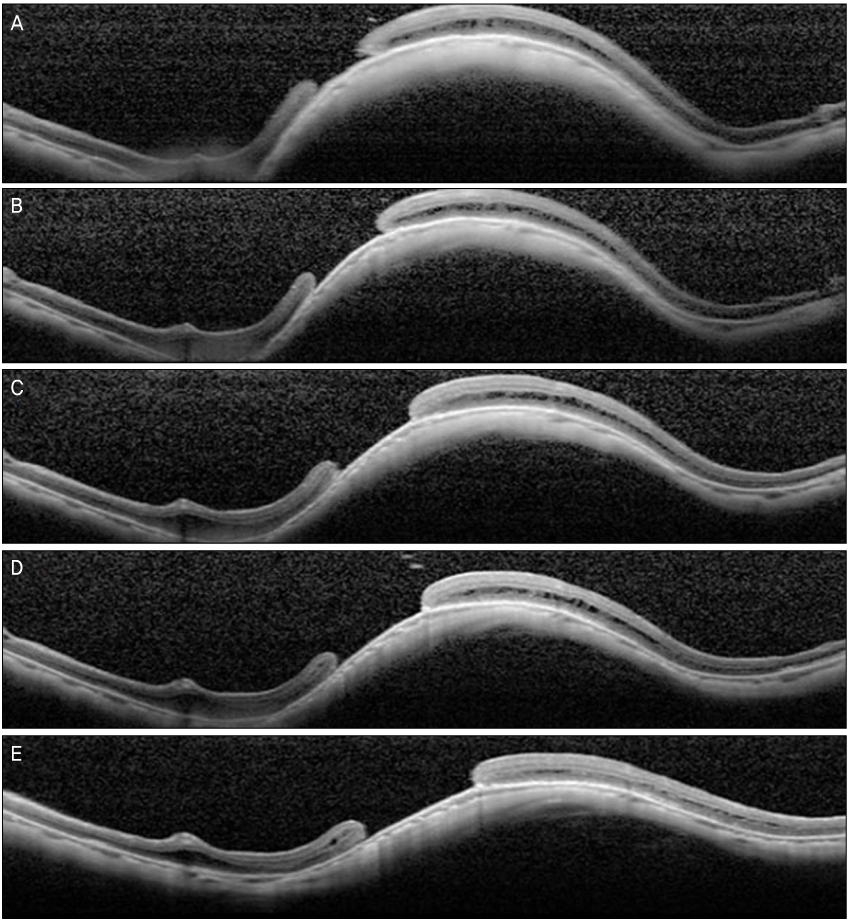J Korean Ophthalmol Soc.
2012 Jul;53(7):969-976. 10.3341/jkos.2012.53.7.969.
The Macular Buckling Procedure for Retinal Detachment Associated with a Macular Hole in High Myopia
- Affiliations
-
- 1Department of Ophthalmology, Samsung Medical Center, Sungkyunkwan University School of Medicine, Seoul, Korea. swkang@skku.edu
- KMID: 2215855
- DOI: http://doi.org/10.3341/jkos.2012.53.7.969
Abstract
- PURPOSE
To evaluate the long-term anatomical and functional results of macular buckling for retinal detachment associated with a macular hole in high myopia.
METHODS
Eleven consecutive highly myopic eyes with retinal detachment and macular holes were retrospectively studied between January 2002 and September 2010. All cases developed after pars plana vitrectomy for internal limiting membrane removal, for the treatment of retinal detachment associated with a macular hole, or vitreomacular traction with a macular hole. Macular buckling with an episcleral sponge was performed for all cases. The mean follow-up period after macular buckling was 45.1 months (range from 12 to 102 months). Retinal reattachment and macular hole closure after the surgery and best-corrected visual acuity before and after the surgery were evaluated.
RESULTS
Nine out of 11 eyes were successfully treated with the macular buckling procedure. In the remaining 2 eyes, retinal re-detachment occurred with anterior proliferative vitreoretinopathy. In these eyes, successful retinal attachment occurred after reoperation with silicone oil tamponade. Optical coherence tomography (OCT) was performed after the surgery in 10 out of 11 eyes and the macular hole closure rate was 30%. The mean best corrected visual acuity went from counting fingers preoperatively to 0.06 postoperatively.
CONCLUSIONS
The macular buckling procedure is effective for retinal detachment associated with a macular hole in high myopia, especially following an unsuccessful pars plana vitrectomy with removal of inner retinal traction.
Keyword
MeSH Terms
Figure
Cited by 1 articles
-
Silicone Oil with Short-Term Prone Position in Macular Hole Retinal Detachment Surgery in High Myopia
Ju Hong Park, Moo Hyun Kim, Min Sagong, Woo Hyok Chang
J Korean Ophthalmol Soc. 2015;56(10):1566-1571. doi: 10.3341/jkos.2015.56.10.1566.
Reference
-
1. Howard GM, Campbell CJ. Surgical repair of retinal detachments caused by macular holes. Arch Ophthalmol. 1969. 81:317–321.2. Muinos A, Mateus F, Heredia CD. Retinal detachment with holes in the posterior pole. Mod Probl Ophthalmol. 1974. 12:315–321.3. Gonvers M, Machemer R. A new approach to treating retinal detachment with macular hole. Am J Ophthalmol. 1982. 94:468–472.4. Stirpe M, Michels RG. Retinal detachment in highly myopic eyes due to macular holes and epiretinal traction. Retina. 1990. 10:113–114.5. Seike C, Kusaka S, Sakagami K, Ohashi Y. Reopening of macular holes in highly myopic eyes with retinal detachments. Retina. 1997. 17:2–6.6. Oshima Y, Ikuno Y, Motokura M, et al. Complete epiretinal membrane separation in highly myopic eyes with retinal detachment resulting from a macular hole. Am J Ophthalmol. 1998. 126:669–676.7. Ishida S, Yamazaki K, Shinoda K, et al. Macular hole retinal detachment in highly myopic eyes: ultrastructure of surgically removed epiretinal membrane and clinicopathologic correlation. Retina. 2000. 20:176–183.8. Phillips CI, Dobbie JG. Posterior staphyloma and retnal detachment. Am J Ophthalmol. 1963. 55:332–335.9. Siam A. Macular hole with central retinal detachment in high myopia with posterior staphyloma. Br J Ophthalmol. 1969. 53:62–63.10. Lam RF, Lai WW, Cheung BT, et al. Pars plana vitrectomy and perfluoropropane (C3F8) tamponade for retinal detachment due to myopic macular hole: a prognostic factor analysis. Am J Ophthalmol. 2006. 142:938–944.11. Ichibe M, Yoshizawa T, Murakami K, et al. Surgical management of retinal detachment associated with myopic macular hole: anatomic and functional status of the macula. Am J Ophthalmol. 2003. 136:277–284.12. Kadonosono K, Yazama F, Itoh N, et al. Treatment of retinal detachment resulting from myopic macular hole with internal limiting membrane removal. Am J Ophthalmol. 2001. 131:203–207.13. Ikuno Y, Sayanagi K, Oshima T, et al. Optical coherence tomographic findings of macular holes and retinal detachment after vitrectomy in highly myopic eyes. Am J Ophthalmol. 2003. 136:477–481.14. Oie Y, Emi K, Takaoka G, Ikeda T. Effect of indocyanine green staining in peeling of internal limiting membrane for retinal detachment resulting from macular hole in myopic eyes. Ophthalmology. 2007. 114:303–306.15. Nakanishi H, Kuriyama S, Saito I, et al. Prognostic factor analysis in pars plana vitrectomy for retinal detachment attributable to macular hole in high myopia: a multicenter study. Am J Ophthalmol. 2008. 146:198–204.16. Li X, Wang W, Tang S, Zhao J. Gas injection versus vitrectomy with gas for treating retinal detachment owing to macular hole in high myopes. Ophthalmology. 2009. 116:1182–1187.17. Mitamura Y, Takeuchi S, Tsuruoka M. Macular buckling combined with pars plana vitrectomy for complicated retinal detachment due to macular hole. Retina. 2000. 20:669–672.18. Blankenship GW, Ibanez-Langlois S. Treatment of myopic macular hole and detachment. Intravitreal gas exchange. Ophthalmology. 1987. 94:333–336.19. Wolfensberger TJ, Gonvers M, Bovey E. Very long-term follow-up of retinal detachment due to macular hole treated with vitrectomy and air injection. Retina. 2001. 21:678–681.20. Wolfensberger TJ, Gonvers M. Long-term follow-up of retinal detachment due to macular hole in myopic eyes treated by temporary silicone oil tamponade and laser photocoagulation. Ophthalmology. 1999. 106:1786–1791.21. Lu L, Li Y, Cai S, Yang J. Vitreous surgery in highly myopic retinal detachment resulting from a macular hole. Clin Experiment Ophthalmol. 2002. 30:261–265.22. Kwok AK, Cheng LL, Gopal L, et al. Endolaser around macular hole in the management of associated retinal detachment in highly myopic eyes. Retina. 2000. 20:439–444.23. Ando F, Ohba N, Touura K, Hirose H. Anatomical and visual outcomes after episcleral macular buckling compared with those after pars plana vitrectomy for retinal detachment caused by macular hole in highly myopic eyes. Retina. 2007. 27:37–44.24. Choung HK, Chung H. Prognosis of retinal detachment caused by macular hole according to the refractive power. J Korean Ophthalmol Soc. 2002. 43:274–280.25. Haut J, Ullern M, Chermet M, Van Effenterre G. Complications of intraocular injections of silicone combined with vitrectomy. Ophthalmologica. 1980. 180:29–35.26. Gonvers M, Andenmatten R. Temporary silicone oil tamponade and intraocular pressure: an 11-year retrospective study. Eur J Ophthalmol. 1996. 6:74–80.27. Krzystolik MG, D'Amico DJ. Complications of intraocular tamponade: silicone oil versus intraocular gas. Int Ophthalmol Clin. 2000. 40:187–200.28. Deramo VA, Haupert CL, Fekrat S, Postel EA. Hypotony caused by scleral buckle erosion in Marfan syndrome. Am J Ophthalmol. 2001. 132:429–431.29. Nguyen QD, Lashkari K, Hirose T, et al. Erosion and intrusion of silicone rubber scleral buckle. Presentation and management. Retina. 2001. 21:214–220.30. Kuriyama S, Matsumura M, Harada T, et al. Surgical techniques and reattachment rates in retinal detachment due to macular hole. Arch Ophthalmol. 1990. 108:1559–1561.31. Sasoh M, Yoshida S, Ito Y, et al. Macular buckling for retinal detachment due to macular hole in highly myopic eyes with posterior staphyloma. Retina. 2000. 20:445–449.32. Ripandelli G, Coppé AM, Fedeli R, et al. Evaluation of primary surgical procedures for retinal detachment with macular hole in highly myopic eyes: a comparison [corrected] of vitrectomy versus posterior episcleral buckling surgery. Ophthalmology. 2001. 108:2258–2264.33. Ripandelli G, Parisi V, Friberg TR, et al. Retinal detachment associated with macular hole in high myopia: using the vitreous anatomy to optimize the surgical approach. Ophthalmology. 2004. 111:726–731.34. Theodossiadis GP, Theodossiadis PG. The macular buckling procedure in the treatment of retinal detachment in highly myopic eyes with macular hole and posterior staphyloma: mean follow-up of 15 years. Retina. 2005. 25:285–289.35. Matsuo T, Shiraga F, Takasu I, Okanouchi T. Scleral infolding combined with vitrectomy and gas tamponade for retinal detachment with macular holes in highly myopic eyes. Jpn J Ophthalmol. 2001. 45:403–408.
- Full Text Links
- Actions
-
Cited
- CITED
-
- Close
- Share
- Similar articles
-
- The Clinical Study of Macular Hole Retinal Detachment Associated with Peripheral Retinal Hole
- Spontaneous reattachment of retinal detachment with macular hole in nonmyopic patients
- Three Cases of Macular Buckling for Retinal Detachment due to Macular Hole in Highly Myopic Eyes
- Effect of Internal Limiting Membrane Removal in Treatment of Retinal Detachment Caused by Myopic Macular Hole
- The Effect of Pneumoretinopexy on the Retinal Detachment with a Macular Hole




